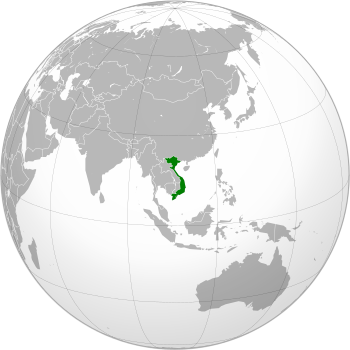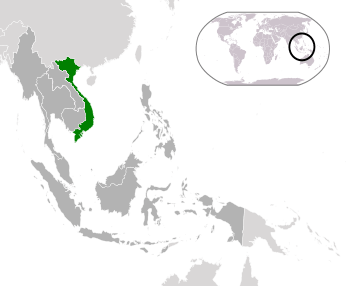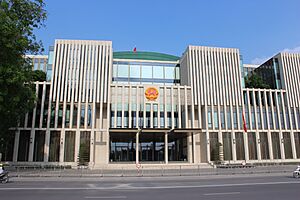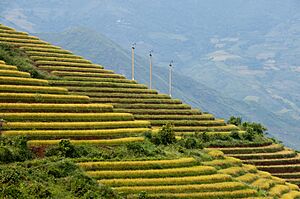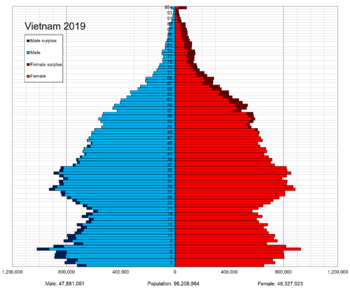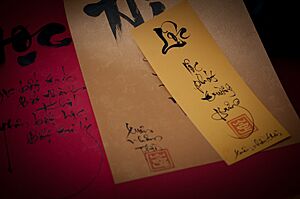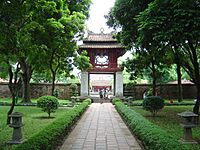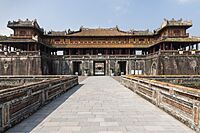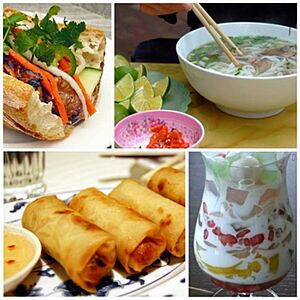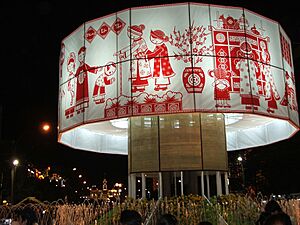Vietnam facts for kids
Quick facts for kids
Socialist Republic of Vietnam
Cộng hòa Xã hội chủ nghĩa Việt Nam (Vietnamese)
|
|
|---|---|
|
|
|
|
Motto: Độc lập – Tự do – Hạnh phúc
"Independence – Freedom – Happiness"
|
|
|
Anthem: Tiến Quân Ca
"The Song of the Marching Troops" |
|
|
Location of Vietnam (green)
in ASEAN (dark grey) |
|
| Capital | Hanoi 21°2′N 105°51′E / 21.033°N 105.850°E |
| Largest city | Ho Chi Minh City 10°48′N 106°39′E / 10.800°N 106.650°E |
| Official language | Vietnamese |
| Ethnic groups
(2019)
|
|
| Religion
(2019)
|
|
| Demonym(s) | Vietnamese Viet (colloquial) |
| Government | Unitary Marxist–Leninist one-party socialist republic |
| Tô Lâm | |
| Lương Cường | |
| Phạm Minh Chính | |
| Legislature | National Assembly |
| Formation | |
|
• Văn Lang
|
7th century BC |
|
• Âu Lạc
|
3rd century BC |
| 111 BC | |
|
• Independence from China
|
939 |
| 1428 | |
|
• Nguyễn's unification
|
1802 |
|
• Protectorate Treaty
|
25 August 1883 |
|
• Declaration of Independence
|
2 September 1945 |
|
• North–South division
|
21 July 1954 |
|
• End of Vietnam War
|
30 April 1975 |
|
• Reunification
|
2 July 1976 |
|
• Đổi Mới
|
18 December 1986 |
|
• Current constitution
|
28 November 2013 |
| Area | |
|
• Total
|
331,344.82 km2 (127,932.95 sq mi) (66th) |
|
• Water (%)
|
6.38 |
| Population | |
|
• 2023 estimate
|
100,300,000 (15th) |
|
• 2019 census
|
96,208,984 |
|
• Density
|
298/km2 (771.8/sq mi) (49th) |
| GDP (PPP) | 2024 estimate |
|
• Total
|
|
|
• Per capita
|
|
| GDP (nominal) | 2024 estimate |
|
• Total
|
|
|
• Per capita
|
|
| Gini (2020) | ▲ 36.8 medium |
| HDI (2022) | high · 107th |
| Currency | Vietnamese đồng (₫) (VND) |
| Time zone | UTC+07:00 (Vietnam Standard Time) |
| Driving side | right |
| Calling code | +84 |
| ISO 3166 code | VN |
| Internet TLD | .vn |
Vietnam is a country in Southeast Asia. The long-form name of the country is the Socialist Republic of Vietnam. Vietnam shares land borders with China to the north, and Laos and Cambodia to the west. It shares maritime borders with Thailand through the Gulf of Thailand, and the Philippines, Indonesia, and Malaysia through the South China Sea. Its capital is Hanoi and its largest city is Ho Chi Minh City (commonly referred to by its former name, Saigon).
Contents
History
Vietnam was inhabited by the Paleolithic age, with states established in the first millennium BC on the Red River Delta in modern-day northern Vietnam. The Han dynasty annexed Northern and Central Vietnam under Chinese rule from 111 BC, until the first dynasty emerged in 939. Successive monarchical dynasties absorbed Chinese influences through Confucianism and Buddhism, and expanded southward to the Mekong Delta, conquering Champa. During most of the 17th and 18th centuries, Vietnam was effectively divided into two domains of Đàng Trong and Đàng Ngoài. The Nguyễn—the last imperial dynasty—surrendered to France in 1883. In 1887, its territory was integrated into French Indochina as three separate regions. In the immediate aftermath of World War II, the nationalist coalition Viet Minh, led by the communist revolutionary Ho Chi Minh, launched the August Revolution and declared Vietnam's independence in 1945.
Vietnam went through prolonged warfare in the 20th century. After World War II, France returned to reclaim colonial power in the First Indochina War, from which Vietnam emerged victorious in 1954. As a result of the treaties signed between the Viet Minh and France, Vietnam was also separated into two parts. The Vietnam War began shortly after, between the communist North Vietnam, supported by the Soviet Union and China, and the anti-communist South Vietnam, supported by the United States. Upon the North Vietnamese victory in 1975, Vietnam reunified as a unitary socialist state under the Communist Party of Vietnam (CPV) in 1976. An ineffective planned economy, a trade embargo by the West, and wars with Cambodia and China crippled the country further. In 1986, the CPV initiated economic and political reforms similar to the Chinese economic reform, transforming the country to a socialist-oriented market economy. The reforms facilitated Vietnamese reintegration into the global economy and politics.
Geography
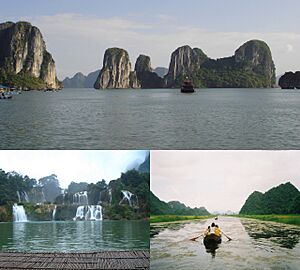
Vietnam is located on the eastern Indochinese Peninsula between the latitudes 8° and 24°N, and the longitudes 102° and 110°E. It covers a total area of 331,210 km2 (127,881 sq mi) or 331,699 km2 (128,070 sq mi). The combined length of the country's land boundaries is 4,639 km (2,883 mi), and its coastline is 3,444 km (2,140 mi) long. At its narrowest point in the central Quảng Bình Province, the country is as little as 50 kilometres (31 mi) across, though it widens to around 600 kilometres (370 mi) in the north. Vietnam's land is mostly hilly and densely forested, with level land covering no more than 20%. Mountains account for 40% of the country's land area, and tropical forests cover around 42%. The Red River Delta in the north, a flat, roughly triangular region covering 15,000 km2 (5,792 sq mi), is smaller but more intensely developed and more densely populated than the Mekong River Delta in the south. Once an inlet of the Gulf of Tonkin, it has been filled in over the millennia by riverine alluvial deposits. The delta, covering about 40,000 km2 (15,444 sq mi), is a low-level plain no more than 3 metres (9.8 ft) above sea level at any point. It is criss-crossed by a maze of rivers and canals, which carry so much sediment that the delta advances 60 to 80 metres (196.9 to 262.5 ft) into the sea every year. The exclusive economic zone of Vietnam covers 417,663 km2 (161,261 sq mi) in the South China Sea.
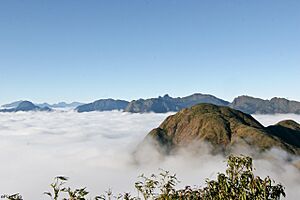
Southern Vietnam is divided into coastal lowlands, the mountains of the Annamite Range, and extensive forests. Comprising five relatively flat plateaus of basalt soil, the highlands account for 16% of the country's arable land and 22% of its total forested land. The soil in much of the southern part of Vietnam is relatively low in nutrients as a result of intense cultivation. Several minor earthquakes have been recorded. The northern part of the country consists mostly of highlands and the Red River Delta. Fansipan (also known as Phan Xi Păng), which is located in Lào Cai Province, is the highest mountain in Vietnam, standing 3,143 m (10,312 ft) high. From north to south Vietnam, the country also has numerous islands; Phú Quốc is the largest. The Hang Sơn Đoòng Cave is considered the largest known cave passage in the world since its discovery in 2009. The Ba Bể Lake and Mekong River are the largest lake and longest river in the country.
Climate
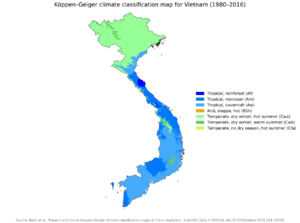
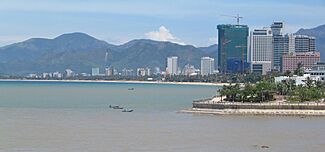
Due to differences in latitude and the marked variety in topographical relief, Vietnam's climate tends to vary considerably for each region. During the winter or dry season, extending roughly from November to April, the monsoon winds usually blow from the northeast along the Chinese coast and across the Gulf of Tonkin, picking up considerable moisture. The average annual temperature is generally higher in the plains than in the mountains, especially in southern Vietnam compared to the north. Temperatures vary less in the southern plains around Ho Chi Minh City and the Mekong Delta, ranging from between 21 and 35 °C (70 and 95 °F) over the year. In Hanoi and the surrounding areas of the Red River Delta, the temperatures are much lower between 15 and 33 °C (59 and 91 °F). Seasonal variations in the mountains, plateaus, and the northernmost areas are much more dramatic, with temperatures varying from 3 °C (37 °F) in December and January to 37 °C (99 °F) in July and August. During winter, snow occasionally falls over the highest peaks of the far northern mountains near the Chinese border. Vietnam receives high rates of precipitation in the form of rainfall with an average amount from 1,500 to 2,000 mm (60 to 80 in) during the monsoon seasons; this often causes flooding, especially in the cities with poor drainage systems. The country is also affected by tropical depressions, tropical storms and typhoons. Vietnam is one of the most vulnerable countries to climate change, with 55% of its population living in low-elevation coastal areas.
Biodiversity
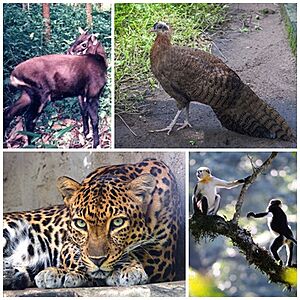
As the country is located within the Indomalayan realm, Vietnam is one of twenty-five countries considered to possess a uniquely high level of biodiversity. This was noted in the country's National Environmental Condition Report in 2005. It is ranked 16th worldwide in biological diversity, being home to approximately 16% of the world's species. 15,986 species of flora have been identified in the country, of which 10% are endemic. Vietnam's fauna includes 307 nematode species, 200 oligochaeta, 145 acarina, 113 springtails, 7,750 insects, 260 reptiles, and 120 amphibians. There are 840 birds and 310 mammals are found in Vietnam, of which 100 birds and 78 mammals are endemic. Vietnam has two World Natural Heritage Sites—the Hạ Long Bay and Phong Nha-Kẻ Bàng National Park—together with nine biosphere reserves, including Cần Giờ Mangrove Forest, Cát Tiên, Cát Bà, Kiên Giang, the Red River Delta, Mekong Delta, Western Nghệ An, Cà Mau, and Cu Lao Cham Marine Park.
Vietnam is also home to 1,438 species of freshwater microalgae, constituting 9.6% of all microalgae species, as well as 794 aquatic invertebrates and 2,458 species of sea fish. In recent years, 13 genera, 222 species, and 30 taxa of flora have been newly described in Vietnam. Six new mammal species, including the saola, giant muntjac and Tonkin snub-nosed monkey have also been discovered, along with one new bird species, the endangered Edwards's pheasant. In the late 1980s, a small population of Javan rhinoceros was found in Cát Tiên National Park. However, the last individual of the species in Vietnam was reportedly shot in 2010. In agricultural genetic diversity, Vietnam is one of the world's twelve original cultivar centres. The Vietnam National Cultivar Gene Bank preserves 12,300 cultivars of 115 species. The Vietnamese government spent US$49.07 million on the preservation of biodiversity in 2004 alone and has established 126 conservation areas, including 30 national parks.
In Vietnam, wildlife poaching has become a major concern. In 2000, a non-governmental organisation (NGO) called Education for Nature – Vietnam was founded to instill in the population the importance of wildlife conservation in the country. In the years that followed, another NGO called GreenViet was formed by Vietnamese youngsters for the enforcement of wildlife protection. Through collaboration between the NGOs and local authorities, many local poaching syndicates were crippled by their leaders' arrests. A study released in 2018 revealed Vietnam is a destination for the illegal export of rhinoceros horns from South Africa due to the demand for them as a medicine and a status symbol.
Government and politics
Vietnam is a unitary Marxist-Leninist one-party socialist republic, one of the two communist states (the other being Laos) in Southeast Asia. Under the constitution, the Communist Party of Vietnam (CPV) asserts their role in all branches of the country's politics and society. The president is the elected head of state and the commander-in-chief of the military, serving as the chairman of the Council of Supreme Defence and Security, and holds the second highest office in Vietnam as well as performing executive functions and state appointments and setting policy.
The general secretary of the CPV performs numerous key administrative functions, controlling the party's national organisation. The prime minister is the head of government, presiding over a council of ministers composed of five deputy prime ministers and the heads of 26 ministries and commissions. Only political organisations affiliated with or endorsed by the CPV are permitted to contest elections in Vietnam. These include the Vietnamese Fatherland Front and worker and trade unionist parties.
The National Assembly of Vietnam is the unicameral state legislature composed of 500 members. Headed by a chairman, it is superior to both the executive and judicial branches, with all government ministers being appointed from members of the National Assembly. The Supreme People's Court of Vietnam, headed by a chief justice, is the country's highest court of appeal, though it is also answerable to the National Assembly. Beneath the Supreme People's Court stand the provincial municipal courts and many local courts. Military courts possess special jurisdiction in matters of state security. Vietnam maintains the death penalty for numerous offences.
Administrative divisions
Vietnam is divided into 58 provinces (Vietnamese: Tỉnh, chữ Hán: 省). There are also five municipalities (thành phố trực thuộc trung ương), which are administratively on the same level as provinces.
|
|

Provinces are subdivided into provincial municipalities (thành phố trực thuộc tỉnh, 'city under province'), townships (thị xã) and counties (huyện), which are in turn subdivided into towns (thị trấn) or communes (xã).
Centrally controlled municipalities are subdivided into districts (quận) and counties, which are further subdivided into wards (phường).
Economy
| Share of world GDP (PPP) | |
|---|---|
| Year | Share |
| 1980 | 0.21% |
| 1990 | 0.28% |
| 2000 | 0.39% |
| 2010 | 0.52% |
| 2020 | 0.80% |
Throughout the history of Vietnam, its economy has been based largely on agriculture—primarily wet rice cultivation. Bauxite, an important material in the production of aluminium, is mined in central Vietnam. Since reunification, the country's economy is shaped primarily by the CPV through Five Year Plans decided upon at the plenary sessions of the Central Committee and national congresses. The collectivisation of farms, factories, and capital goods was carried out as part of the establishment of central planning, with millions of people working for state enterprises. Under strict state control, Vietnam's economy continued to be plagued by inefficiency, corruption in state-owned enterprises, poor quality and underproduction. With the decline in economic aid from its main trading partner, the Soviet Union, following the erosion of the Eastern bloc in the late 1980s, and the subsequent collapse of the Soviet Union, as well as the negative impacts of the post-war trade embargo imposed by the United States, Vietnam began to liberalise its trade by devaluing its exchange rate to increase exports and embarked on a policy of economic development.

In 1986, the Sixth National Congress of the CPV introduced socialist-oriented market economic reforms as part of the Đổi Mới reform program. Private ownership began to be encouraged in industry, commerce and agriculture and state enterprises were restructured to operate under market constraints. This led to the five-year economic plans being replaced by the socialist-oriented market mechanism. As a result of these reforms, Vietnam achieved approximately 8% annual gross domestic product (GDP) growth between 1990 and 1997. The United States ended its economic embargo against Vietnam in early 1994. Although the 1997 Asian financial crisis caused an economic slowdown to 4–5% growth per year, its economy began to recover in 1999, and grew at around 7% per year from 2000 to 2005, one of the fastest in the world. On 11 January 2007, Vietnam became the 150th member of the WTO (World Trade Organization). According to the General Statistics Office of Vietnam (GSO), growth remained strong despite the late-2000s global recession, holding at 6.8% in 2010. Vietnam's year-on-year inflation rate reached 11.8% in December 2010 and the currency, the Vietnamese đồng, was devalued three times.
Deep poverty, defined as the percentage of the population living on less than $1 per day, has declined significantly in Vietnam and the relative poverty rate is now less than that of China, India and the Philippines.
Agriculture
As a result of several land reform measures, Vietnam has become a major exporter of agricultural products. It is now the world's largest producer of cashew nuts, with a one-third global share; the largest producer of black pepper, accounting for one-third of the world's market; and the second-largest rice exporter in the world after Thailand since the 1990s. Subsequently, Vietnam is also the world's second largest exporter of coffee. The country has the highest proportion of land use for permanent crops together with other states in the Greater Mekong Subregion. Other primary exports include tea, rubber and fishery products. Agriculture's share of Vietnam's GDP has fallen in recent decades, declining from 42% in 1989 to 20% in 2006 as production in other sectors of the economy has risen.
Seafood
The overall fisheries production of Vietnam from capture fisheries and aquaculture was 5.6 million MT in 2011 and 6.7 million MT in 2016. The output of Vietnam's fisheries sector has seen strong growth, which could be attributed to the continued expansion of the aquaculture sub-sector.
Science and technology
In 2010, Vietnam's total state spending on science and technology amounted to roughly 0.45% of its GDP. Vietnamese scientists have made many significant contributions in various fields of study, most notably in mathematics. Hoàng Tụy pioneered the applied mathematics field of global optimisation in the 20th century, while Ngô Bảo Châu won the 2010 Fields Medal for his proof of fundamental lemma in the theory of automorphic forms. Since the establishment of the Vietnam Academy of Science and Technology (VAST) by the government in 1975, the country is working to develop its first national space flight program especially after the completion of the infrastructure at the Vietnam Space Centre (VSC) in 2018. Vietnam has also made significant advances in the development of robots, such as the TOPIO humanoid model. One of Vietnam's main messaging apps, Zalo, was developed by Vương Quang Khải, a Vietnamese hacker who later worked with the country's largest information technology service company, the FPT Group.
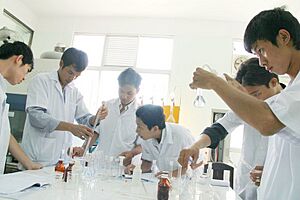
According to the UNESCO Institute for Statistics, Vietnam devoted 0.19% of its GDP to science research and development in 2011. Vietnam was ranked 46th in the Global Innovation Index in 2023, it has increased its ranking considerably since 2012, where it was ranked 76th. Between 2005 and 2014, the number of Vietnamese scientific publications recorded in Thomson Reuters' Web of Science increased at a rate well above the average for Southeast Asia, albeit from a modest starting point. Publications focus mainly on life sciences (22%), physics (13%) and engineering (13%), which is consistent with recent advances in the production of diagnostic equipment and shipbuilding.
Tourism
Tourism is an important element of economic activity in the nation, contributing 7.5% of the total GDP. Vietnam hosted roughly 13 million tourists in 2017, an increase of 29.1% over the previous year, making it one of the fastest growing tourist destinations in the world. The vast majority of the tourists in the country, some 9.7 million, came from Asia; namely China (4 million), South Korea (2.6 million), and Japan (798,119). Vietnam also attracts large numbers of visitors from Europe, with almost 1.9 million visitors in 2017; most European visitors came from Russia (574,164), followed by the United Kingdom (283,537), France (255,396), and Germany (199,872). Other significant international arrivals by nationality include the United States (614,117) and Australia (370,438).
The most visited destinations in Vietnam are the largest city, Ho Chi Minh City, with over 5.8 million international arrivals, followed by Hanoi with 4.6 million and Hạ Long, including Hạ Long Bay with 4.4 million arrivals. All three are ranked in the top 100 most visited cities in the world. Vietnam is home to eight UNESCO World Heritage Sites. In 2018, Travel + Leisure ranked Hội An as one of the world's top 15 best destinations to visit.
Education
Vietnam has an extensive state-controlled network of schools, colleges, and universities and a growing number of privately run and partially privatised institutions. General education in Vietnam is divided into five categories: kindergarten, elementary schools, middle schools, high schools, and universities. A large number of public schools have been constructed across the country to raise the national literacy rate, which stood at 90% in 2008. Most universities are located in major cities of Hanoi and Ho Chi Minh City with the country's education system continuously undergoing a series of reforms by the government. Basic education in the country is relatively free for the poor although some families may still have trouble paying tuition fees for their children without some form of public or private assistance. Regardless, Vietnam's school enrolment is among the highest in the world. The number of colleges and universities increased dramatically in the 2000s from 178 in 2000 to 299 in 2005. In higher education, the government provides subsidised loans for students through the national bank, although there are deep concerns about access to the loans as well the burden on students to repay them.Since 1995, enrolment in higher education has grown tenfold to over 2.2 million with 84,000 lecturers and 419 institutions of higher education. A number of foreign universities operate private campuses in Vietnam, including Harvard University (United States) and the Royal Melbourne Institute of Technology (Australia). The government's strong commitment to education has fostered significant growth but still need to be sustained to retain academics. In 2018, a decree on university autonomy allowing them to operate independently without ministerial control is in its final stages of approval. The government will continue investing in education especially for the poor to have access to basic education.
Demographics
Ethnic groups of Vietnam Vietnamese (85.32%) Other (14.68%)
As of 2018[update], the population of Vietnam stands at approximately 95.5 million people. The dominant Viet or Kinh ethnic group constitute 82,085,826 people or 85.32% of the population. Most of their population is concentrated in the country's alluvial deltas and coastal plains.
Religion
Religion in Vietnam (2019) Vietnamese folk religion or no religion (86.32%) Buddhism (4.79%) Catholicism (6.1%) Protestantism (1.0%) Hoahaoism (1.02%) Caodaism (0.58%) Islam (0.07%) Others (0.12%)
Under Article 70 of the 1992 Constitution of Vietnam, all citizens enjoy freedom of belief and religion. All religions are equal before the law and each place of worship is protected under Vietnamese state law. Religious beliefs cannot be misused to undermine state law and policies. According to a 2007 survey 81% of Vietnamese people did not believe in a god.
The majority of Vietnamese do not follow any organised religion, though many of them observe some form of Vietnamese folk religion. Confucianism as a system of social and ethical philosophy still has certain influences in modern Vietnam. Mahāyāna is the dominant branch of Buddhism, while Theravāda is practised mostly by the Khmer minority. About 8 to 9% of the population is Christian—made up of Roman Catholics and Protestants. Southeast Asia#Vietnam|Hindus among the Cham]]'s.
Languages
The national language of the country is Vietnamese, a tonal Austroasiatic language (Mon–Khmer), which is spoken by the majority of the population. Vietnam's minority groups speak a variety of languages, including: Tày, Mường, Cham, Khmer, Chinese, Nùng and Hmong. The Montagnard peoples of the Central Highlands also speak a number of distinct languages, some belonging to the Austroasiatic and others to the Malayo-Polynesian language families. In recent years, a number of sign languages have developed in the major cities.
The French language, a legacy of colonial rule, is spoken by many educated Vietnamese as a second language, especially among the older generation and those educated in the former South Vietnam, where it was a principal language in administration, education and commerce. Vietnam remains a full member of the International Organisation of the Francophonie (La Francophonie) and education has revived some interest in the language. Russian, and to a lesser extent German, Czech and Polish are known among some northern Vietnamese whose families had ties with the Eastern Bloc during the Cold War. With improved relations with Western countries and recent reforms in Vietnamese administration, English has been increasingly used as a second language and the study of English is now obligatory in most schools either alongside or in place of French. The popularity of Japanese, Korean, and Mandarin Chinese have also grown as the country's ties with other East Asian nations have strengthened. Third-graders can choose one of seven languages (English, Russian, French, Chinese, Japanese, Korean, German) as their first foreign language. In Vietnam's high school graduation examinations, students can take their foreign language exam in one of the above-mentioned languages.
Culture
Vietnamese culture is considered part of Sinosphere. Vietnam's culture has developed over the centuries from indigenous ancient Đông Sơn culture with wet rice cultivation as its economic base. Some elements of the nation's culture have Chinese origins, drawing on elements of Confucianism, Mahāyāna Buddhism, and Taoism in its traditional political system and philosophy. Vietnamese society is structured around làng (ancestral villages); all Vietnamese mark a common ancestral anniversary on the tenth day of the third lunar month. The influence of Chinese culture such as the Cantonese, Hakka, Hokkien, and Hainanese cultures is more evident in the north where Buddhism is strongly entwined with popular culture. Despite this, there are Chinatowns in the south, such as in Chợ Lớn, where many Chinese have intermarried with Kinh and are indistinguishable among them. In the central and southern parts of Vietnam, traces of Champa and Khmer culture are evidenced through the remains of ruins, artefacts as well within their population as the successor of the ancient Sa Huỳnh culture. In recent centuries, Western cultures have become popular among recent generations of Vietnamese.
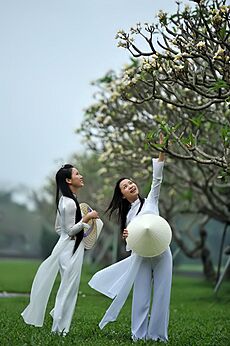
The traditional focuses of Vietnamese culture are based on humanity (nhân nghĩa) and harmony (hòa) in which family and community values are highly regarded. Vietnam reveres a number of key cultural symbols, such as the Vietnamese dragon which is derived from crocodile and snake imagery; Vietnam's national father, Lạc Long Quân is depicted as a holy dragon. The lạc is a holy bird representing Vietnam's national mother Âu Cơ. Other prominent images that are also revered are the turtle, buffalo and horse. Many Vietnamese also believe in the supernatural and spiritualism where illness can be brought on by a curse or sorcery or caused by non-observance of a religious ethic. Traditional medical practitioners, amulets and other forms of spiritual protection and religious practices may be employed to treat the ill person. In the modern era, the cultural life of Vietnam has been deeply influenced by government-controlled media and cultural programs. For many decades, foreign cultural influences, especially those of Western origin, were shunned. But since the recent reformation, Vietnam has seen a greater exposure to neighbouring Southeast Asian, East Asian as well to Western culture and media.
The main Vietnamese formal dress, the áo dài is worn for special occasions such as weddings and religious festivals. White áo dài is the required uniform for girls in many high schools across the country. Other examples of traditional Vietnamese clothing include: the áo tứ thân, a four-piece woman's dress; the áo ngũ, a form of the thân in five-piece form, mostly worn in the north of the country; the yếm, a woman's undergarment; the áo bà ba, rural working "pyjamas" for men and women; the áo gấm, a formal brocade tunic for government receptions; and the áo the, a variant of the áo gấm worn by grooms at weddings. Traditional headwear includes the standard conical nón lá, the "lampshade-like" nón quai thao, and the traditional turban, khăn vấn. In tourism, a number of popular cultural tourist destinations include the former Imperial City of Huế, the World Heritage Sites of Phong Nha-Kẻ Bàng National Park, Hội An and Mỹ Sơn, coastal regions such as Nha Trang, the caves of Hạ Long Bay and the Marble Mountains.
Cuisine
Traditionally, Vietnamese cuisine is based around five fundamental taste "elements" (Vietnamese: ngũ vị): spicy (metal), sour (wood), bitter (fire), salty (water) and sweet (earth). Common ingredients include fish sauce, shrimp paste, soy sauce, rice, fresh herbs, fruits and vegetables. Vietnamese recipes use: lemongrass, ginger, mint, Vietnamese mint, long coriander, Saigon cinnamon, bird's eye chilli, lime and basil leaves. Traditional Vietnamese cooking is known for its fresh ingredients, minimal use of oil and reliance on herbs and vegetables; it is considered one of the healthiest cuisines worldwide. The use of meats such as pork, beef and chicken was relatively limited in the past. Instead freshwater fish, crustaceans (particularly crabs), and molluscs became widely used. Fish sauce, soy sauce, prawn sauce and limes are among the main flavouring ingredients. Vietnam has a strong street food culture, with 40 popular dishes commonly found throughout the country. Many notable Vietnamese dishes such as gỏi cuốn (salad roll), bánh cuốn (rice noodle roll), bún riêu (rice vermicelli soup) and phở noodles originated in the north and were introduced to central and southern Vietnam by northern migrants. Local foods in the north are often less spicy than southern dishes, as the colder northern climate limits the production and availability of spices. Black pepper is frequently used in place of chillis to produce spicy flavours. Vietnamese drinks in the south also are usually served cold with ice cubes, especially during the annual hot seasons; in contrast, in the north hot drinks are more preferable in a colder climate. Some examples of basic Vietnamese drinks include cà phê đá (Vietnamese iced coffee), cà phê trứng (egg coffee), chanh muối (salted pickled lime juice), cơm rượu (glutinous rice wine), nước mía (sugarcane juice) and trà sen (Vietnamese lotus tea).
Holidays and festivals
The country has eleven national recognised holidays. These include: New Year's Day on 1 January; Vietnamese New Year (Tết Nguyên Đán) from the last day of the last lunar month to fifth day of the first lunar month; Hùng Kings' Festival on the 10th day of the third lunar month; Reunification Day on 30 April; International Workers' Day on 1 May; and National Day on 2 September. During Tết, many Vietnamese from the major cities will return to their villages for family reunions and to pray for dead ancestors. Older people will usually give the young a lì xì (red envelope) while special holiday food, such as bánh chưng (rice cake) in a square shape together with variety of dried fruits, are presented in the house for visitors. Many other festivals are celebrated throughout the seasons, including the Tết Nguyên Tiêu, Tết Trung Thu and various temple and nature festivals. In the highlands, Elephant Race Festivals are held annually during the spring; riders will ride their elephants for about 1.6 km (0.99 mi) and the winning elephant will be given sugarcane. Traditional Vietnamese weddings remain widely popular.
Sports

The Vovinam, Kim Kê and Võ Bình Định are widespread in Vietnam, while football is the country's most popular sport. Its national team won the ASEAN Football Championship twice in 2008 and 2018 and reached the quarter-finals of 2019 AFC Asian Cup, its junior team of under-23 became the runners-up of 2018 AFC U-23 Championship and reached fourth place in 2018 Asian Games, while the under-20 managed to qualify the 2017 FIFA U-20 World Cup for the first time in their football history. The national football women's team also traditionally dominates the Southeast Asian Games, along with its chief rival, Thailand. Other Western sports such as badminton, tennis, volleyball, ping-pong and chess are also widely popular. Vietnam has participated in the Summer Olympic Games since 1952. After the partition of the country in 1954, only South Vietnam competed in the games, sending athletes to the 1956 and 1972 Olympics. Since the reunification of Vietnam in 1976, it has competed as the Socialist Republic of Vietnam, attending every Summer Olympics from 1988 onwards. The present Vietnam Olympic Committee was formed in 1976 and recognised by the International Olympic Committee (IOC) in 1979. Vietnam has never participated in the Winter Olympic Games. In 2016, Vietnam won their first gold medal at the Olympics. Basketball has become an increasingly popular sport in Vietnam, especially in Ho Chi Minh City, Hanoi and Sóc Trăng.
Related pages
Images for kids
-
French Indochina circa 1930.
-
The Grand Palais built for the 1902–1903 world's fair as Hanoi became French Indochina's capital.
-
The pink lotus, widely regarded by the Vietnamese as the national flower of the country, symbolises beauty, commitment, health, honour and knowledge.
-
Natural fog in northwest Vietnam (Tây Bắc).
-
The port of Hai Phong is one of the largest and busiest container ports in Vietnam.
-
In rural areas of Vietnam, piped water systems are operated by a wide variety of institutions including a national organisation, people committees (local government), community groups, co-operatives and private companies.
-
Cultural dance performed by one of 54 recognised Vietnamese ethnic groups.
See also
 In Spanish: Vietnam para niños
In Spanish: Vietnam para niños




